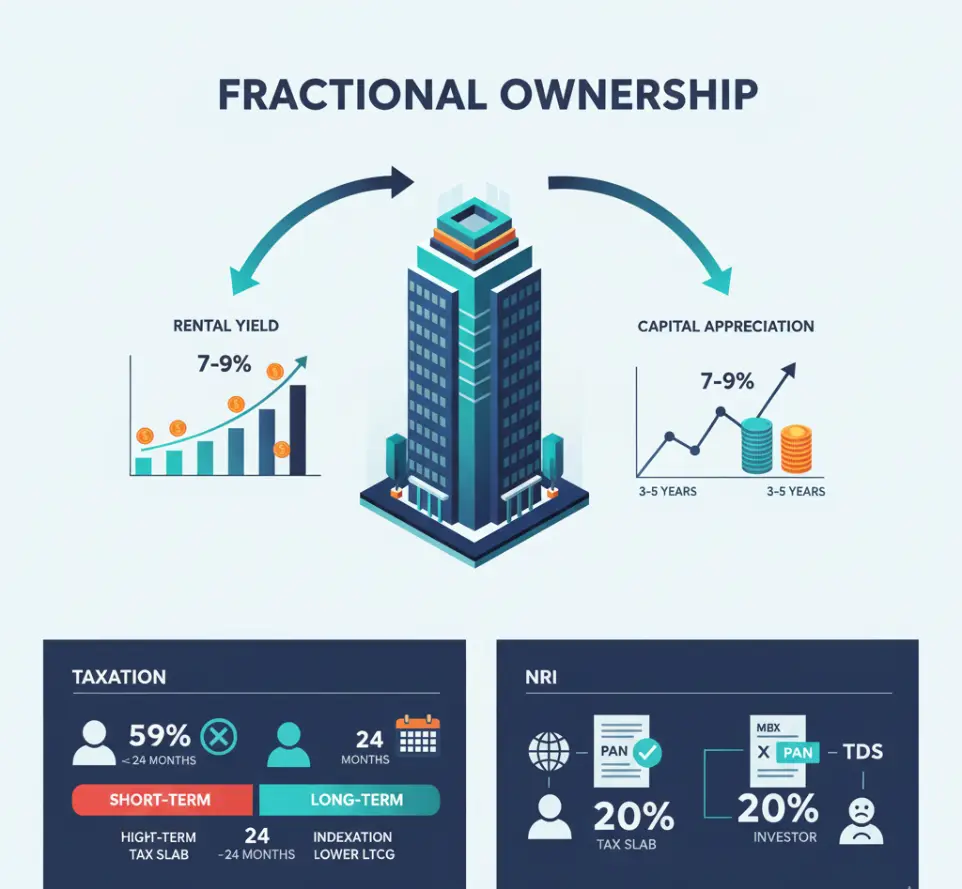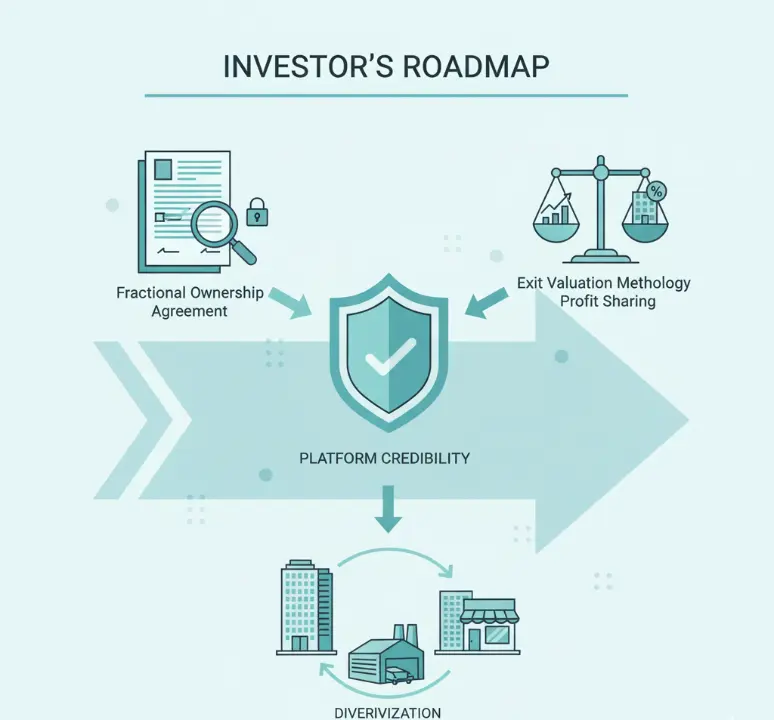🌐 The Structure of Fractional Ownership in India
An Experienced Investor’s Roadmap 🚀
When you step into the world of real estate investing in India today, one term you keep hearing again and again is Fractional Ownership. And let me tell you, as someone who has seen this market grow and transform over decades, the concept of fractional ownership is not just another passing trend. It is a serious, disruptive, and highly strategic way of entering into Commercial Real Estate (CRE) without burning a hole of several crores in your pocket. 💡
For years, high-value office spaces, warehouses, and retail outlets in India were a playing field reserved exclusively for ultra-rich families, HNIs, and institutional investors. The minimum entry ticket used to be in the range of ₹10–20 crores. Imagine a young professional or even a successful business owner trying to enter this arena impossible, right? ❌ But the beauty of fractional ownership is that it has restructured this entire narrative.
Through Fractional Ownership Platforms (FOPs), now even someone with ₹10–25 lakhs can buy a share of premium commercial assets that yield consistent rental income and appreciate strongly over time. And this is not just storytelling this is already happening. The market value of fractional ownership in India was around ₹1,500 crore in 2019, and by 2023 it jumped to ₹4,000 crore. 📈 Analysts further expect the market to surge to USD 8.9 billion by 2025. These are not small numbers; these are indicators of a revolution in motion. 🔥

🌟 The Experience of Watching Real Estate Democratize
Having spent years studying the Indian real estate cycle, I can tell you that every major boom was triggered when access was widened. In the early 2000s, residential housing finance changed the game. Today, it is fractional ownership that is institutionalizing access to Indian CRE. And trust me, the word “democratization” is often overused in marketing brochures, but here it is genuinely reshaping the ecosystem. 🏙️
Yet, one must understand that democratization here is relative. The typical entry barrier of ₹10–25 lakhs is not exactly “mass retail.” It is more suited to the upper-middle-class investor, NRIs, and HNIs who cannot shell out ₹10 crores for a building but can certainly commit 15–20 lakhs for a solid cash-flowing asset. So, this model is not for everyone. And that exclusivity itself keeps the quality of investors and the seriousness of the platform high.
🏢 The Mechanism That Powers Fractional Ownership
Imagine you and nine of your friends pool money to buy a Grade A office space in Bengaluru worth ₹50 crores. Instead of any one of you taking the entire burden, each of you buys 10% ownership through an SPV (Special Purpose Vehicle) or LLP (Limited Liability Partnership). What happens then? Simple: you share the rent income every month, and when the property value grows and is sold, you also share the capital appreciation.
This is exactly how FOPs functionexcept at scale, with highly professionalized structures, audited agreements, and tech platforms that allow investors across the globe to participate. The assets they select are often leased to Fortune 500 companies or large Indian corporates, meaning your income is secured by long-term leases. The yields? Typically 7–9% annually, which is far superior to residential real estate where you barely get 2–3%.
But more than the yield, what attracts seasoned investors like me is the stability. These assets are managed by professionals, the tenants are usually blue-chip, and the leases are long-termoften 9 years with built-in escalations every 3 years. That is the holy grail for anyone seeking stable, passive income. 💰

📜 The Legal Backbone: Why Structure Matters
Now let me share an insider’s perspective. In real estate, the structure matters more than the property. You can own the best office space in Mumbai, but if your legal structure is flawed, your returns are at risk. Fractional ownership in India is anchored around SPVs entities hold the actual property, and investors buy shares or debentures in the SPV.
Earlier, these platforms worked in a regulatory gray area. Investors had to trust the due diligence of the platform. But everything changed in March 2024 when SEBI introduced Small and Medium REITs (SM REITs). This is the single most transformative step in India’s investment regulation in recent years.
Now every fractional ownership platform that wants to be credible must fall under the SM REIT umbrella. This means:
Only completed, income-generating assets can be listed.
Each scheme must be between ₹50 crore and ₹500 crore.
Minimum investment is fixed at ₹10 lakhs.
95% of distributable cash flows must be returned to investors every quarter.
Annual third-party valuations are mandatory.
This regulatory framework cleansed the sector of shady operators overnight. Now, when you invest, you are not only betting on the property but also on a governance system enforced by SEBI. And let me tell you, institutional investors love this kind of discipline.


💰 The Financial Reality
Let’s get practical. Investors don’t enter CRE for philosophy they want numbers. Fractional ownership provides two primary sources of return: steady rental yield (7–9%) and capital appreciation when the property is sold after 3–5 years.
But here comes the tricky part: taxation. As per Indian tax law, your share of rent is treated as Income from House Property. You get a 30% standard deduction, which is a blessing, but the remaining is taxed at your slab rate. On the capital gain side, if you sell before 2 years, it is Short-Term Capital Gain (STCG) taxed at your slab rate, which could be as high as 42%. If you hold for more than 2 years, it becomes Long-Term Capital Gain (LTCG) with indexation benefits. That small difference of one month can save you lakhs. This is why seasoned investors never exit before 24 months.
And for NRIs, taxation gets even more complex. Miss submitting your PAN, and TDS on rent shoots from 2% to 20%. That’s why strict compliance and due diligence are non-negotiable. I always tell new investors real estate doesn’t punish ignorance instantly, but when it does, the pain is lifelong.

✨ Conclusion
Fractional ownership is not just about owning a piece of real estate. It’s about owning a piece of India’s economic future. For investors who seek predictable income, stable growth, and exposure to premium commercial properties without the headache of managing tenants and maintenance, this is a once-in-a-generation opportunity.
But remember this game rewards the patient, the diligent, and the wise. Do your due diligence, read every agreement, trust only credible platforms, and think long-term. If you do, fractional ownership will not just be an investment for you it will be an education in how wealth is built, preserved, and grown. 💎

